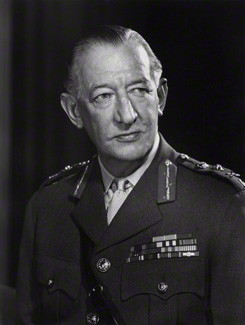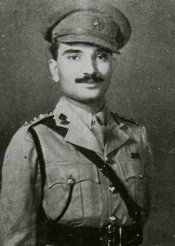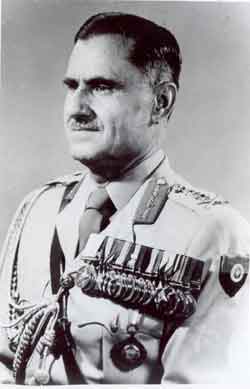
The 4th Infantry Division, also known as the Red Eagle Division, is an infantry division of the Indian Army. This division of the British Indian Army was formed in Egypt in 1939 during the Second World War. During the Second World War, it took part in campaigns in East Africa, Syria, North Africa and Italy. Post independence, the division is part of the I Corps and headquartered at Prayagraj.

Field Marshal Sir Archibald James Halkett Cassels, was a senior British Army officer who served as Chief of the General Staff (CGS), the professional head of the British Army, from 1965 to 1968. As a young man he was a first-class cricket player, initially playing in India for the Europeans against the Hindus in the Lahore Tournament and going on to play for a Punjab Governor's XI against Northern India team and for a Viceroy's XI against the Roshanara Club. He later played for the British Army cricket team against the RAF at The Oval and then played for the Egyptian national side against HM Martineau's XI in Alexandria.

Lieutenant General Premindra Singh Bhagat, PVSM, VC was a general in the Indian Army and an Indian recipient of the Victoria Cross, the highest and most prestigious award for gallantry in the face of the enemy that can be awarded to British and Commonwealth forces. The Victoria Cross was conferred on him for his actions in the Sudan Theatre during World War II.

General Tapishwar "Tappy" Narain Raina, best known as T.N. Raina, was a senior army officer and a diplomat who served as the 9th Chief of the Army Staff of the Indian Army between 1975 and 1978.
Brij Mohan Kaul (1912–1972) was a Lieutenant General in the Indian Army. He served as the Chief of General Staff during 1961–1962 and was regarded as a key architect of Indian military response to the Chinese challenge. In October 1962, he was given the command of a newly raised IV Corps to counter the impending Chinese invasion of NEFA, but it got routed by the Chinese. He resigned in the aftermath of the war, and was awarded the Param Vishisht Seva Medal in 1960.
A King's commissioned Indian officer (KCIO) was an Indian officer of the British Indian Army who held a full King's commission after training in the United Kingdom, either at the Royal Military College, Sandhurst for infantry officers, Woolwich for artillery officers, and Chatham and Woolwich for engineer officers. They had full command over British and Indian troops and officers. In contrast, the Indian commissioned officers (ICOs), who were trained at the Indian Military Academy at Dehra Dun, and the Viceroy's commissioned officers (VCOs), only had authority over Indian troops and officers. KCIOs were introduced in the early 20th century under the Indianisation process. They were equivalent in every way to the British officers holding a King's commission. In essence, they were commissioned by the King himself at a special induction ceremony. They held the same ranks and privileges as British officers. In fact, most KCIOs served on attachment to a British unit for a year or two early in their careers.

General Kodendera Subayya Thimayya, DSO was the 3rd Chief of Army Staff from 1957 to 1961 during the crucial years leading up to the conflict with China in 1962. Thimayya was the only Indian to command an Infantry brigade in battle during the Second World War and is regarded as the most distinguished combat officer the Indian Army has produced. After the Korean War, Thimayya headed a United Nations unit dealing with the repatriation of prisoners of war. After his retirement from the Army, he was appointed Commander of the United Nations Peace Keeping Force in Cyprus from July 1964 to December 1965 and died in Cyprus while on active duty on 18 December 1965.

The 12th Frontier Force Regiment was formed in 1922 as part of the British Indian Army. It consisted of five regular battalions; numbered 1 to 5 and the 10th (Training) Battalion. During the Second World War a further ten battalions were raised. In 1945, the prenominal "12th" was dropped when the British Indian Army dispensed with prenominal numbering of its regiments. After the independence in 1947, it was formed into the Frontier Force Regiment, part of the army of Pakistan.

The 14th Indian Infantry Division was an infantry division of the Indian Army during World War II. It fought in the Arakan Campaign 1942–43, and was subsequently converted into a Training Division, providing drafts of replacements for units of the Fourteenth Army during the Burma Campaign.

Brigadier Kuldip Singh Chandpuri MVC, VSM was a decorated Indian Army officer. He is known for his leadership in the Battle of Longewala during the Indo-Pakistani War of 1971, for which he was awarded the Maha Vir Chakra, the second highest Indian military decoration, by the Indian government. The 1997 Hindi film Border was based on the battle, with his role played by Sunny Deol. He was a councillor in the Chandigarh Municipal Corporation from 2006 to 2011.

Major General Thomas Wynford Rees, was a Welsh officer in the British Indian Army during the First World War, the interwar years and the Second World War

The 25th Infantry Division was an infantry division of the Indian Army during World War II which fought in the Burma Campaign. It was re-raised within the post-independence Indian Army in 1948.

Lieutenant General Harbaksh Singh, VrC was an Indian senior military officer. As the commander of the Western Command, Singh commanded the Indian Army and played a key role during the Indo-Pakistani War of 1965. For his role in the war, he was awarded the Padma Vibhushan in 1966.
Brigadier John Hume Prendergast DSO MC & Bar was a British Indian Army, and later British Army, officer and travel writer.

General Pran Nath Thapar was the fourth Chief of Army Staff of the Indian Army. The Sino-Indian War was fought during his term, in which the Indian Army fared poorly. Thapar resigned during the last stages of the war, handing charge to Lt. Gen. J. N. Chaudhuri.
The Punjab Boundary Force was an ad hoc military force to restore law and order during the communal carnages of the partition of India in the Punjab. The force was based on the 4th Indian Division and commanded by Maj Gen T.W. Rees. The force was unable to execute its task successfully and it was disbanded so that the newly formed dominion armies of India and Pakistan could take charge of the situation.

Lieutenant General Pattacheruvanda Chengappa Thimayya, PVSM, VSM, ADC is a former General Officer in the Indian Army. He was the 21st General Officer Commanding-in-Chief (GOC-in-C) Army Training Command. He assumed office on 1 November 2018 from Lt Gen Manoj Mukund Naravane.

Lieutenant General Raj Shukla, PVSM,YSM, SM, ADC is a retired General Officer of the Indian Army who served as the General Officer Commanding-in-Chief of the Army Training Command. He assumed office on 1 May 2020, succeeding Lt Gen P C Thimayya. He superannuated on 31 March 2022. He is currently, a member of the Union Public Service Commission.

Lieutenant General Naveen Chand Rawlley, PVSM, AVSM, MC was a General Officer in the Indian Army. He served as the General Officer Commanding-in-Chief Eastern Command before taking over as the 5th Vice Chief of the Army Staff.
Exercise Lal Qila was a military exercise conducted on 17 March 1960, at the headquarters of the Indian Army's Eastern Command in Lucknow. The wargame simulated an attack on India's eastern sector by the Chinese armed forces. While the exercise was conducted to sensitize the leadership, it did not have the desired effect.














